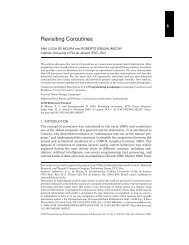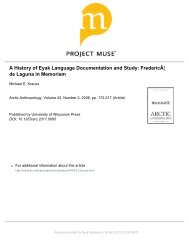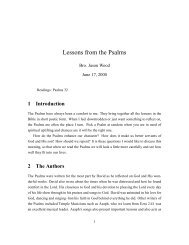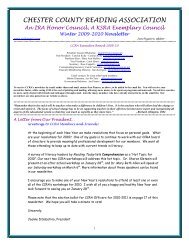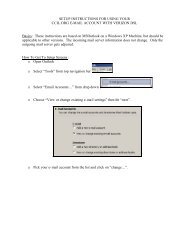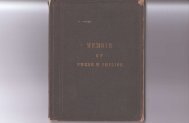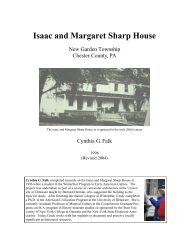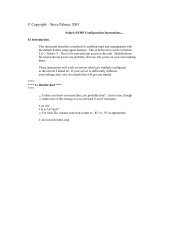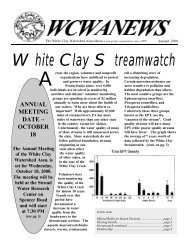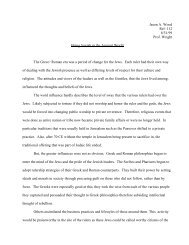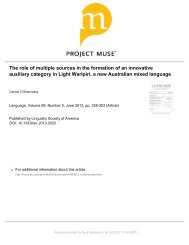You also want an ePaper? Increase the reach of your titles
YUMPU automatically turns print PDFs into web optimized ePapers that Google loves.
Wilkins added a small circle or hook, at the top,<br />
middle, or base, to represent one of six vowels. Thus<br />
the composite symbol represented a syllable, either<br />
vowel þ consonant or consonant þ vowel. Each category<br />
of sound, such as oral stop consonant, fricative,<br />
or nasal, had a characteristic shape, as did voiceless<br />
and voiced sounds at the same place of articulation.<br />
The system was ingenious, but the symbols could<br />
easily be confused, and it is unlikely that anyone<br />
other than Wilkins actually used it (see Figure 2B).<br />
Wilkins’s contemporary, Francis Lodwick (see<br />
Lodwick, Francis (1619–1694)), published a similar<br />
system in 1686 under the title An essay towards an<br />
universal alphabet. He stated in his text the important<br />
principle that ‘‘no one character should have more<br />
than one sound, nor any one sound be expressed by<br />
more than one character.’’ The notation was a syllabary,<br />
using shapes designed to show similarities between<br />
the sounds symbolized, which are set out in a<br />
table with six places of articulation: bilabial, dental,<br />
palatal, velar, labiodental, and alveolar. The top symbol<br />
in each column is the voiced stop, and the lower<br />
ones are formed by progressive modifications of it. As<br />
with Wilkins’s system, the vowels are added to the<br />
consonant symbols as diacritics.<br />
Another iconic alphabet is to be found in chapter 5<br />
of the Traité de la formation méchanique des langues,<br />
published in 1765 by the French scholar and magistrate,<br />
Charles de Brosses (see Brosses, Charles de<br />
(1709–1777)). The work was intended for scholars<br />
researching into languages, rather than for everyday<br />
use. Brosses called it ‘organic and universal.’ It is<br />
based on a somewhat idiosyncratic analysis of speech<br />
production, which, among other things, assumed that<br />
the vowels were sounded at different points on a<br />
corde, or string, equivalent to the vocal tract tube.<br />
Brosses’s understanding of speech production is suspect<br />
in a number of ways; for example, he classes<br />
as a nasal consonant. His first attempt at notation<br />
was complex, using symbols that pictured the<br />
outline of the different vocal organs (lips, teeth, palate,<br />
nose, etc.), but he simplified this subsequently,<br />
using symbols made up of curves and straight lines<br />
at different angles. The vowel symbols were attached<br />
to the consonants to give a syllabic sign, and the<br />
notation included composite symbols to represent<br />
consonant clusters.<br />
Nineteenth-Century <strong>Transcription</strong><br />
Systems<br />
Volney and the Volney Prize<br />
The French orientalist, statesman, and reformer,<br />
Count Constantin François Volney (see Volney,<br />
<strong>Phonetic</strong> <strong>Transcription</strong>: <strong>History</strong> 401<br />
Constantin-Francois Chasseboeuf, Comte de<br />
(1757–1820)), had been concerned for many years<br />
about the difficulties experienced by Europeans in<br />
learning oriental languages, and the poor standard<br />
of the teaching of these languages. His book, Simplification<br />
des langues orientales (Paris, 1795), put forward<br />
a system for transliterating Arabic, Persian, and<br />
Turkish into Roman script, supplemented by a few<br />
Greek letters and some newly invented symbols. During<br />
a visit to America from 1795 to 1798, he stayed<br />
with William Thornton, and while there became<br />
acquainted with Sir William Jones’s alphabet. He<br />
conceived the idea of a universal alphabet, not for<br />
scholarly purposes, but to act as a practical tool for<br />
travelers, traders, etc. His 1795 system was used with<br />
modifications for geographical names on the map of<br />
Egypt compiled in 1803 by the French government,<br />
but his later L’Alphabet européen appliqué aux langues<br />
asiatiques (Paris, 1819) provided a fuller system<br />
of 60 symbols, mostly Roman, replacing some of his<br />
previous, newly invented, symbols with more familiar<br />
letters modified by diacritics. However, Volney realized<br />
that further research was needed, and his final<br />
gesture was to leave 24 000 francs in his will, for a<br />
prize to be awarded by the Institut de France to<br />
anyone who could devise a suitable ‘harmonic alphabet’<br />
(to bring harmony out the existing confusion of<br />
practices) in Roman script (see Kemp, 1999).<br />
The Volney Prize for the first year (1822) was to be<br />
for an essay setting out the necessary conditions for<br />
such an alphabet. The prizewinners were both German<br />
librarians: Josef Scherer (d. 1829) argued that<br />
what was needed was a transcription reflecting pronunciation,<br />
rather than a transliteration, whereas<br />
A. A. E. Schleiermacher (1787–1858), the co-winner,<br />
favored a transliteration, for very much the same<br />
reasons as those given by Sir William Jones. Scherer<br />
and Schleiermacher submitted detailed transcription<br />
systems for the 1823 prize, which was won by<br />
Scherer; Schleiermacher’s essay was submitted later<br />
in a revised form and was published in 1835. He<br />
continued to work on his system, and his completed<br />
scheme, Das harmonische oder allgemeine Alphabet<br />
zur <strong>Transcription</strong> fremder Schriftsysteme in lateinische<br />
Schrift (The harmonic or general alphabet for<br />
the transcription of foreign writing systems into Latin<br />
script), was eventually published in Darmstadt, after<br />
his death (1864). Together with his new alphabet, this<br />
work contained examples of the non-Roman scripts<br />
of 10 languages. In all, 275 new characters had to be<br />
cast. His notation excluded digraphs and letters from<br />
other alphabets, which he felt would be typographically<br />
unsuitable, so his main resource was diacritics,<br />
both above and below the basic symbols. Some<br />
of these were used systematically (e.g., to indicate



